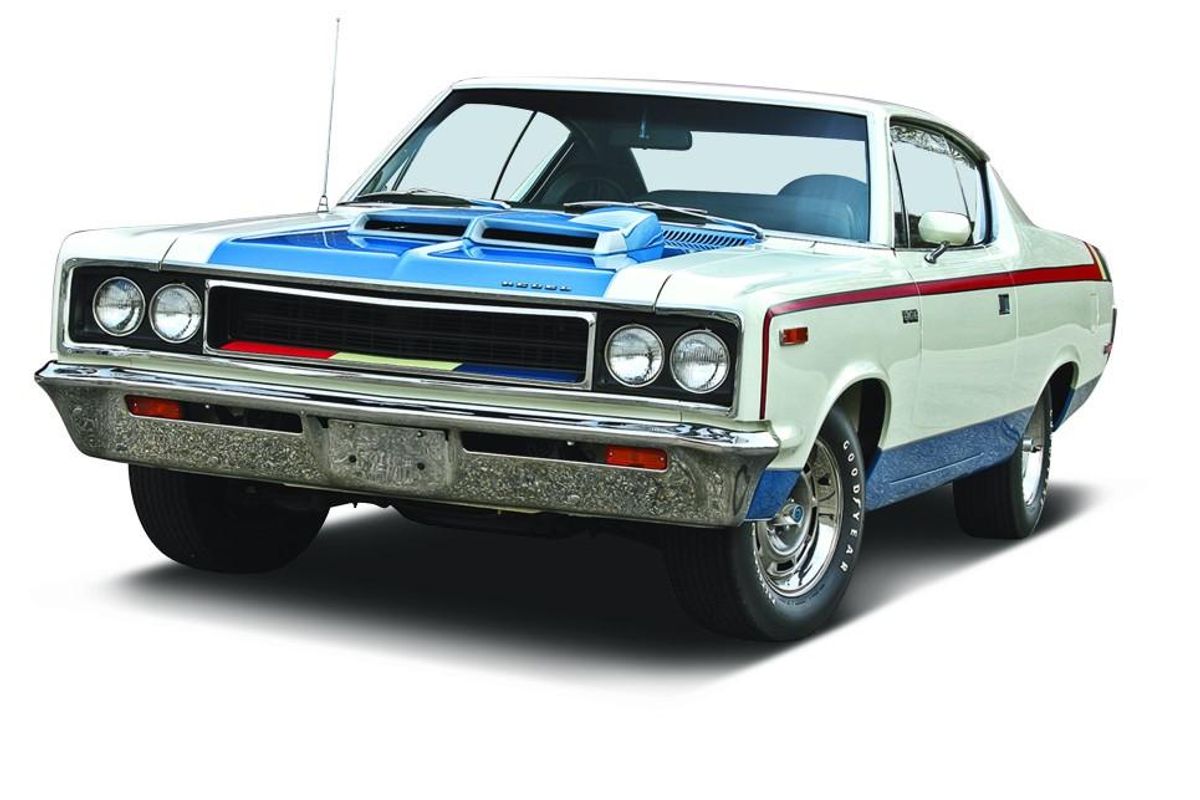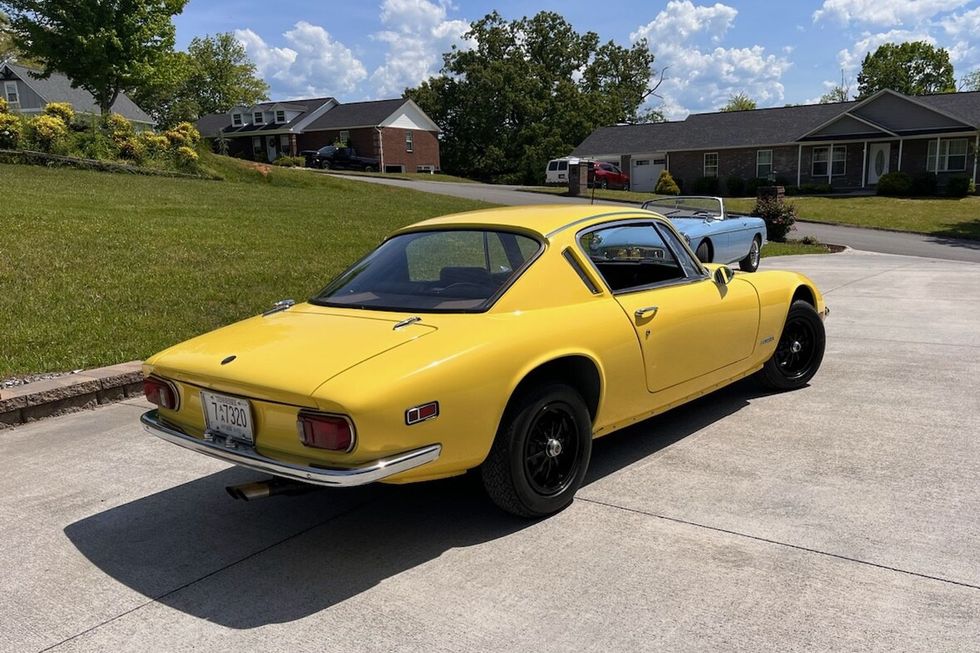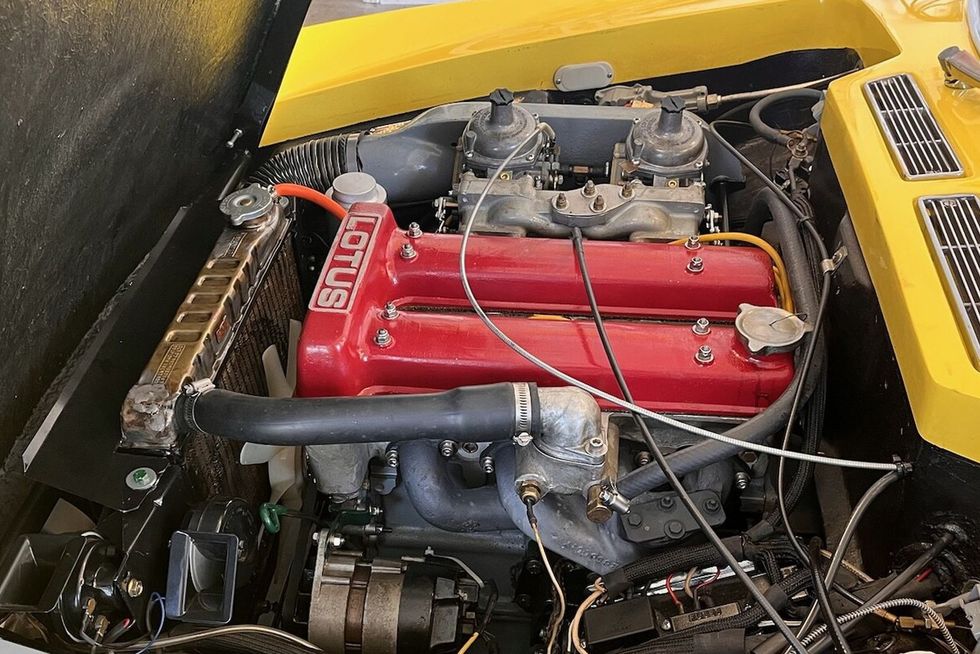1970 AMC Rebel Machine
Another fabulous one-and-done high-performance special from the krazy kids in Kenosha
09/23/2018


Anyone looking at Rambler's staid history could reasonably ask where such a fully-formed, utterly-conventional muscle car came from. Truth is, it was a gradual process.
The Rebel name was attached to a hot Rambler as early as 1957 (the four-door Rebel was America's quickest sedan that year, behind only a fuel-injected Corvette), so there was some history of speed behind the moniker. The Rebel name disappeared from 1961 to '65, but was given to the full range of AMC intermediates when the name returned for the 1967 model year.
That year, 1967, the Rebel's top engine was a 280-hp four-barrel 343-cube V-8. For 1968, the two-barrel, 235-hp 390-cube V-8 became an option. And it was 1968 when Kenosha's engineers got with the performance program that had been raging in Detroit and across America for the previous half a decade or more: The two-seat AMX and four-seat Javelin had debuted to great acclaim (and not a few sales), and the Hurst-fettled SC/Rambler, which shared some chassis components (plus the 315-hp 390 V-8) with the Javelin and AMX, was on its way. Availability of the AMX 390, as it was known, started in May of 1968.
Despite styling studies that showed a wingless, flat-hooded, all-black Rebel coupe from the summer of '68--an AMC counter-statement meant to rail against the candy-colored psychedelia of the era--the result, launched in October, 1969, was seen in a red, white and blue color scheme that made the idea of American Motors a very literal one, indeed.
Initially, the two-door hardtop Rebel Machine was available only in red, white and blue--a white body with red stripes that went up the front fender and down the length of the body, and a blue hood section that incorporated the combination functional hood scoop/tachometer. (Solid body-color Machines, minus the side tape stripes and with black hood stripes instead of blue, were available after January 1, 1970--and could furthermore be decked out with an optional vinyl top that the RWB Machines could not get.) The paint scheme didn't match the SC/Rambler or the RWB AMC Trans-Am and NHRA race-day specials, but it was still all-American enough that you didn't need to guess who was behind its creation. A Hurst shifter attached to the Borg-Warner T10 four-speed manual was part of the package as well; automatic-equipped, pistol-grip-shifted Machines made due with Borg-Warner Shift Command.
But the big news in the Machine was the engine: For 1970, the Machine's 390-cu.in. V-8 made 340 hp and a whopping 430 lb-ft of torque. It topped that year's AMX power output by 15 horsepower. It shared a camshaft, 10:1 compression, and forged connecting rods and crank with the AMX's 390, and added a high-flow dual-plane intake, dog-leg port heads, and larger 2¼-inch-outlet exhaust manifolds. A letter Y in the VIN identified the 340-hp engine.
Suspension was fortified from the parts bin: Rear coil springs from a Rebel station wagon, plus front and rear anti-roll bars (the rear thicker than the front) made for a tauter ride and flatter cornering. Power front disc brakes, a standard 3.54:1 rear-axle ratio (3.91:1 optional), stamped-steel 15 x 7 Kelsey-Hayes wheels, and a heavy-duty cooling package were also part of The Machine. MSRP was $3,475, when a base GTO was priced at $3,267.
There is some discrepancy over the number of Machines built for the year: The National American Motor Drivers and Racers Association (NAMDRA) claims that 1,936 were built, with 1,340 of these (and all of the first 300) in the RWB paint scheme. Sources at the 1970 Rebel Machine Registry claim that 2,326 Machines were made. Whichever number you choose to believe, there still weren't many to go around.
The Machine was a one-year-only deal. For 1971, AMC turned its attention to the compact Hornet-based SC/360, and the Machine was no more. The facelifted Rebel for 1971 was renamed Matador, and though a 330-hp 401/four-speed Matador was available in 1971, fewer than 50 people sought to equip one this way.
SPECIFICATIONS
Engine: OHV V-8, iron block; 389.6-cu.in.
Horsepower: 340 @ 5,100 RPM
Bore x stroke: 4.165 x 3.574 inches
Torque: 430-lb.ft. @ 3,600 RPM
Transmission: Borg-Warner T-10 four-speed manual with 10.5-inch clutch and Hurst shifter
Wheelbase: 114.0 inches
Length: 199.0 inches
Width: 77.2
Weight: 3,650 pounds
Price new: $3,475
Porsche has confirmed the official arrival of its hybrid 911 model, which will see its full debut on Tuesday, May 28. Whether or not sports car enthusiasts and Porsche aficionados accept the new hybrid as the newest 911 model, the sports car’s performance capabilities can’t be denied.
In its press release, Porsche boasted that its engineers logged over 3,000,000 test miles on the new 911. The hybrid was subjected to testing in the Artic Circle’s extreme cold environment and the unbearably hot deserts of Dubai, but Porsche didn’t stop there. Stop-and-go traffic scenarios were vigorously tested for drivers who plan to daily drive their new 911.
Perhaps the most impressive tests took place on the famous Nürburgring circuit. Porsche claims that Le Mans World Champion driver Jörg Bergmeister took the wheel, piloting the hybrid-powered 911 around the course in just 7:16.934 minutes, which is reportedly “8.7 seconds faster than the corresponding version of the predecessor model.”
Porsche has not yet released full performance data for the 2025 911, so it’s difficult to say exactly what those comparisons look like. Since the math makes sense, Porsche could be comparing the hybrid 911 to the 992 Carrera 4 GTS, which lapped the Nürburgring in 7:25.632. What we do know is that the 493-horsepower GT4 RS completed a lap at the Nürburgring in 7:03.121 minutes, just 14 seconds quicker than the road-going hybrid.
“For the first time in our icon’s 61-year history, we are installing a hybrid drive system in a roadgoing 911. This innovative performance hybrid makes the 911 even more dynamic,” Frank Moser, Vice President of 911 and 18 said. “We left nothing to chance during development and tested the new 911 under all sorts of conditions all over the world. Whether at a high drivetrain load in the demanding conditions of mountain passes or in the stop-and-go traffic of an urban environment, the new 911 has mastered even the most difficult challenges with aplomb."
Stay tuned for more details on May 28, when Porsche is scheduled to reveal the beginning of a new era, the hybrid 911 sports car.
In the early 1960s, Lotus debuted the Elan, an extremely lightweight, exceptionally small sports car. With its backbone chassis and fiberglass body, the Elan—available as a roadster or fixed-roof coupe—weighed a little over 1,500 pounds. A Ford Kent-based engine with a twin-cam, 16-valve cylinder head gave the diminutive sports car brisk performance, allowing the tiny Elan to punch well above its weight class. One thing thin the Elan was never noted for, however, was comfort, nor convenience, what with only two seats.
Enter the Elan +2, a much larger car built with the same design and engineering features, but with space for two children in the back and more comfort for the driver and front passenger. The Plus 2 debuted in 1967 and not long after an updated version, the +2S, was released with additional luxuries. Unlike the Elan, the +2 was only ever produced as a coupe. This 1972 Lotus Elan +2S 130 now offered on Hemmings Auctions appears to be a road-ready example of the first four-seater from Lotus. The “130” portion of the name came from the revised, higher-output 126-horsepower engine in the model released in the early 1970s.

Like the original, the Elan +2S featured a backbone frame and a fiberglass body. Though still compact by almost any definition of a car from the 1960s, the four-seater was bigger in every dimension. Lotus designers and engineers were tasked with creating a car that “must be capable of transporting two adults and two children 1,000 miles in comfort with their luggage.” The Plus 2’s 96-inch wheelbase was a foot longer than the original. And its overall length of 169 inches was a full two feet longer than the earlier car. Additionally, it measured 10 inches wider and two inches taller. The Plus 2 was still relatively small, itself measuring one foot shorter in both wheelbase and overall length compared to a 1965 Ford Mustang Hardtop.
Those plus-size dimensions greatly contributed to the comfort inside the car, but with road testers of the day still praising the car for maintaining the Elan’s adroit handling. Motor Sport magazine from the U.K. described the Plus 2’s steering as “incredibly light and precise.” In detail, they wrote, “The all-round independent suspension with its racing-like wishbone and link lay-out gives the car superb handling, of that there is no doubt. The glory of it is that you can whip along country lanes with their twists and turns without drama, in complete safety and not working hard while drivers in lesser vehicles struggle to keep up.”

The “big-valve” version of the 1,558-cc Lotus-designed/Ford-based twin-cam four-cylinder engine in the +2S 130 was rated at 126 horsepower and 113 lb-ft of torque, giving the car brisk acceleration, as it weighed a little over 2,000 pounds. A four-speed manual directed power to the rear wheels. Road testers of the +2S and +2S 130 models reported 0-60 mph times at right around, or even just under, eight seconds.
Technically, by 1972, there was no such model as the Elan +2S. Rather, Lotus dubbed the car the +2S 130, or alternatively the Plus 2 130. In either case, despite the obvious origins and former use of the name with the model, “Elan” was dropped from the moniker by that time. The Elan name did reappear the following year. Though Elan production ceased in 1973, the Elan +2 continued through 1974.

The notes on this 1972 Lotus Elan +2S 130 currently listed on Hemmings Auctions indicate that this Plus 2 has been restored, including a rebuild of its original engine and four-speed manual transmission, completed some 3,000 miles ago. The seller shared that the water, oil and fuel pumps were replaced, while the radiator was rebuilt. Additional fresh components are said to be the brake discs, updated Rotoflex drive couplings and wheel bearings, all as part of a chassis rebuild.
The seller reports that the fiberglass bodied was disassembled, repaired and professionally refinished before reassembly. The original brightwork was rechromed as necessary and the original glass reinstalled with new seals. Fresh Pirelli Cinturato rubber was mounted on refinished original Lotus 10-spoke alloy wheels. According to the Classic Lotus Elan Register, this +2S 130 is one of 1,879 +2S and +2S 130 models built out of a total production run of 5,139 Elan +2’s.
Take a look at this 1972 +2S 130 at Hemmings Auctions to see what a right-sized Lotus Elan looks like.
